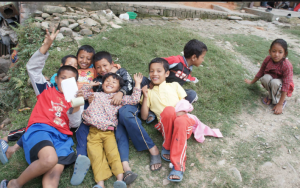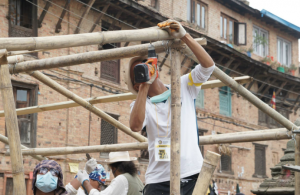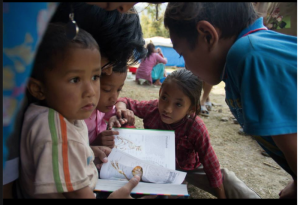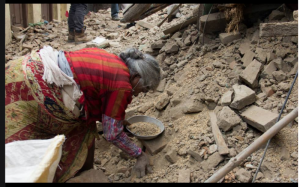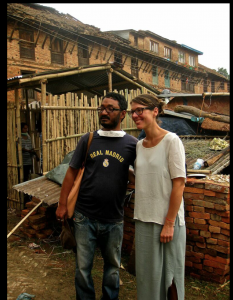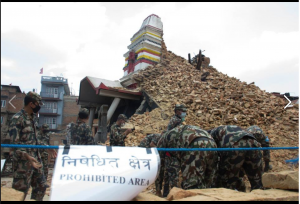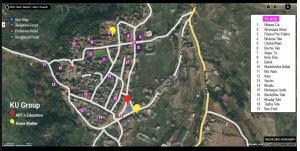Patrons in Heidelberg: Christiane Brosius, with Nadine Plachta & Roberta Mandoki
Bungamati is – used to be – a beautiful small town, a bit off the beaten tourist track with about 6000 inhabitants. It is said to be the birthplace of the Rato Matsyendranath, one of the key deities for the local Newar people. The city – particularly the old part – has been diminished to rubble with the earthquake of April 2015, rendering many citizens homeless and traumatised (estimations talk of 1200 displaced families). Even though the city lies only a few kilometres south of Patan and Kathmandu, it has so far been only at the periphery of relief work.
Since 6.5., a team of about 100 volunteers has started relief work, and they envisage to be there for a long time, helping to build shelters, rebuilt the old city, as Sujan Chitrakar, one of the main organisers behin this, says: “helping to restore it to its olden glory”. Sujan is professor of Art and Design at Kathmandu University. His department has been badly damaged too. But for the time being, the ‘classes’ take place outdoor, and by means of voluntary help: his colleagues and around 90 students have been organized in teams to cater to different needs, be it the construction of shelters (two were built on the first day already). The highly motivated groups provide help to older people with no family support or to traumatised children, for instance by offering drawing and painting workshops, to get the minds off the memory of the last days. On the longterm, the initiative plans to develop a Master Plan, and for this they need help from highly specialized engineers and architects.
The anthropologist Christiane Brosius knows and works with Sujan Chitrakar since 3 years, Nadine Plachta, the representative of the South Asia Institute’s branch office in Kathmandu, will accompany the work of this group in the next weeks, and report to us about the proceedings so that we can react with appropriate financial measures. Roberta Mandoki, member of a research project on Ageing in Nepal, is also active in this project. Writes Nadine about Sujan’s project ‘Rebuilding Bungamati’: “His Focus is on those aged people who have no near or even distant family support and can sustain themselves only with great difficulties, if at all. Sujan (and his team) build temporary shelters and toilets that meant to last for 1-2 years, and maybe this can turn into a community of elderly. Besides, the art students also look after traumatised children, by means of painting or drawing workshops, they provide drawing materials and let the children draw their experiences, listen to their stories, record them.” (5.5.15) See the blog online since 9.6.2015 made by student volunteers of the initiative, their facebook-page as well as the updated report by C Brosius.
This is a map made by a volunteer from Kathmandu University, showing some of the key landmarks for identification (since so much is destroyed) and where the two temporary shelters were built – and completed! – today.
In an interview with Nadine Plachta (NP) two weeks after the earthquake on 24.4.2015, Sujan Chitrakar (SC)comments on the work he and his colleagues and students from the Department of Art and Design engages in since they started. (comments by Christiane Brosius: CB):
SC: “There are many people who are still facing those kinds of trauma, not just because they have lost their house and their property, also because the experience they had was terrible, you know, they are scared of their own houses. And how things are in Nepal – people invest their live in one house and when it goes, there is nothing left. The attachment with the property is very intense – it is like that anywhere in the world I guess. So even every brick counts for them, it’s for them, it’s like an engagement for attachment, if you see someone fighting for every brick, you have to be aware that every brick has a history with their live. So when that’s crumbling and when that’s not safe for them, it’s a problem for them. So with that thing (the suicide) happening yesterday we are still thinking how we can cope with that post-trauma situation. We have many things planned -we want to go at least for a longer period of time, we don’t want to go parachuting everywhere and try to put our banner but we are doing what we can, and develop a role model, to see how an institute (he refers to the Department of Art & Design that he is heading, CB) can make a change, rather than going around and having lots of coverage. We are active in small places.
NP: How did it come that you chose Bungamati? SC: … Bungamati, it’s in Lalitpur an it’s a suburb town and we thought why not go to Bungamati, because we heard that Bungamati was very badly hit and there is serious sanitation problem also. … There was one comment that by a person that since we were artists we should go and maybe paint some signs, or maybe give information. Then it just clicked in our mind that no, art this is not just like this: we can do more than what people think we are supposed to do. So we thought we should adopt Bungamati in such a way that we contribute to Bungamati on the long run, you know, not just coming here and parachuting in. Have small things to do for a change. So we thought Bungamati would be the ideal place for us, for a few reasons: One is, it’s twelve years of celebration of Matsyendranath (this is the most important procession undertaken by Newar people in the Kathmandu Valley, where every 12th year, the procession chariot starts from Bungamati, the birthplace of Lord Matsyendranath, and is pulled to Patan, CB) – and there are lots of artisants. They’re like skilled people, but they haven’t been in the limelight. There are so many craftsmen over there, and so many people are active during their freetime, they weave, for instance. Like this, in a way Bungamati is small and underestimatet town, with lots of craftsmen and expertise around. Thirdly, Bungamati is just a few kilometers away from Hattiban (where the art college is, albeit destroyed after the earthquake, CB). So if I have to mobilise my students I cannot take to them to Ghorka, so Bungamati is very close, just few kilometers away (…), so for me, choosing Bungamati is also encouraging all of our students who can come here. And the fourth thing is that our school is in Lalitpur, and Bungamati is in Lalitpur. That has cultural importance, historical importance, artistic importance – and we can contribute to that. So we thought that why not can an art institution build something for them, and for the future and so, rather than just building a shelter. A shelter is not our main agenda, but Bungamati (as such, CB), you know. So we are very stubborn with all this, insanely stubborn (laughs).
NP: But was it clear for you from the beginning that you want to mobilise your students for a long-term project? Or did that come gradually after you went to Bungamati? SC: For me it’s always been very easy to work with my students, I have always done this. Most of the projects I did, I did with my students. Ideally, if I have to do that my students are always there to support for the good cause, you know, so in so many other
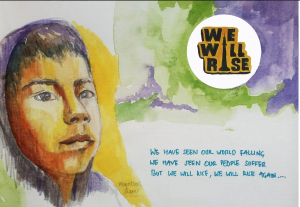
programs, our students have proved that they can do it. So I really believe in their capacity, so all I need is just to mobilise and channelize their energy you know, so that has been my previous idea. But this earthquake I think is kind of a turning point for Nepal, Nepali momentum, the growth of the Nepali momentum can not be the same as two weeks back (before the earthquake, CB). It has completely changed the whole society. So, for me, like, I don’t think we can resume our normal life, our life has taken different route now. So as an academic institution I believe I’d be wrong if I teach a textbook now, that has been prescribed by a committee or by the government. I think we need to revise or revamp that whole system of learning to match this crisis. So I really wanted to have our students to contribute to Bungamati like see how we can be part of this developing process, you know. And this is a tremendous opportunity for us, we’re trying to rebuild a country you know, and if we just go back and stay back we will become like a stupid person on art. So this is a chance, so why not make use of it because if we can, we can do it. So then I thought why not focus on Bungamati because so many people scattered around you know, and even I thought so many of friends who were in this relief distributing materials – everywhere, they have this crisis, they couldn’t build a rapport with people. When I went to Bungamati and tried to talk to people they didn’t have any information, so I thought that’s the wrong way of doing it, you know, so if we stick with Bungamati I would know people around, I would slowly build up rapport. If we can contribute in that particular area, then it would be very helpful, rather then going just and bringing support. So that’s why we decided we won’t go around, focus on Bungamati, people can take of other places, we will try to devote our time here, try to create a role for ourselves, not just for others. So that’s why we focus on Bungamati, I think for me it’s become easier, we don’t have to think of other stuff like that and it becomes more focused at least for the time being.
About the patrons: Christiane Brosius conducts research on and in Nepal since about four years. She has two research projects; the young art scene in the Kathmandu Valley and the topic of Ageing and Mobility in the city of Patan. Roberta Mandoki works on Ageing in Kathmandu, in the same project. The representative of the South Asia Institute in Kathmandu, Nadine Plachta, keeps track of the earthquake-affected Tsum-region as well as “Rebuilding Bungamati”. Moreover, and with Christiane, she will start supporting another project by artists with traumatised children and relief work in Tholo Byasi, Bhaktapur.
